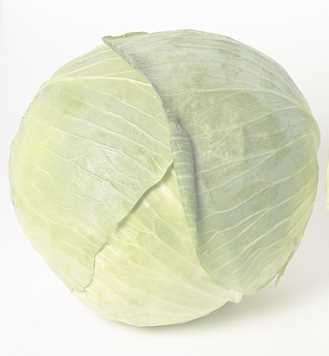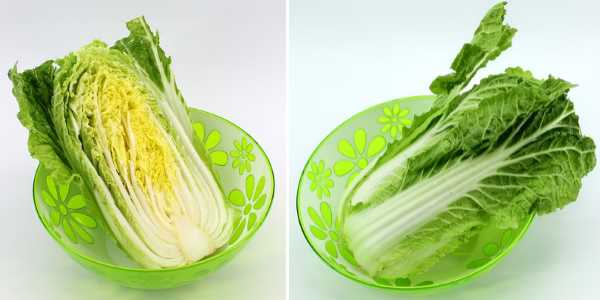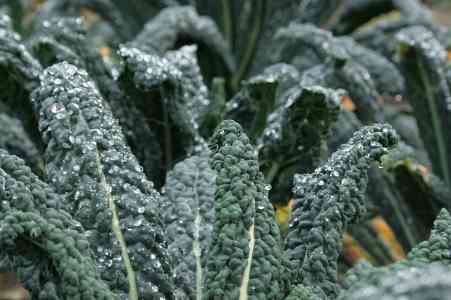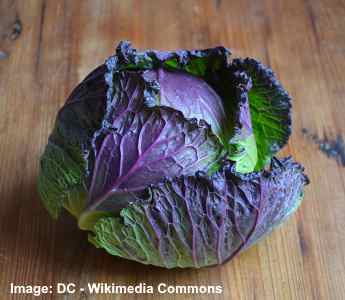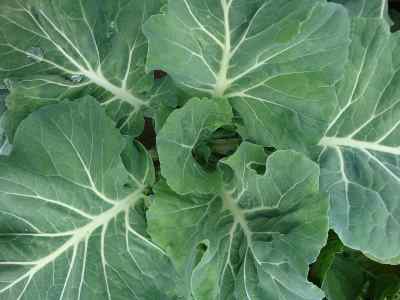Types of Cabbage: Delicious Cabbage Varieties (Including Pictures and Names)
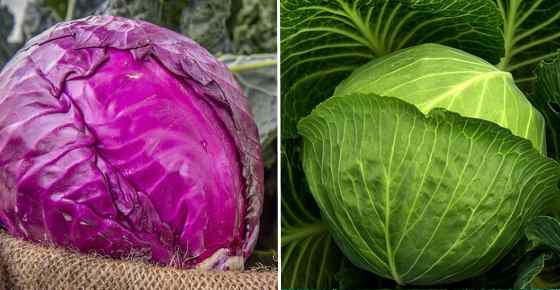
There are hundreds of varieties of cabbage, with green cabbage being the most common. Cabbage is a very healthy type of green leafy vegetable belonging to the Brassica oleracea species. Some of the most common types of cabbage are Savoy cabbage, Napa Cabbage, kale, and Bok Choy. Cabbages come in various colors, with red and white cabbage being the most popular varieties after green.
Because cabbage is in the Brassica genus of plants, this vegetable is related to cauliflower, broccoli, and Brussels sprouts. This means that cabbage is also classed as a cruciferous vegetable.
Different types of cabbage have their own characteristics and taste. For example, some cabbage varieties have smooth leathery leaves whereas others have crinkly leaves. The Napa cabbage has a light subtle taste but regular cabbages have a crunchy texture and peppery flavor.
Cabbage is a versatile vegetable that can be eaten raw or cooked and is a very healthy type of vegetable.
When preparing cabbages to eat raw, steamed or braised, you usually cut away the white part of the stem. This has sometimes an unpalatable taste and is very tough to eat.
Common Types of Cabbage (With Pictures and Names)
Let’s look in more detail at the many varieties of cabbage that you can find in your local store or farmer’s market.
Green Cabbage
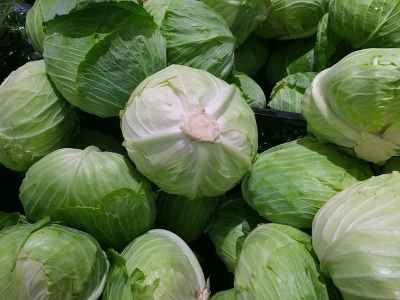
Green cabbage is the most popular type of cabbage and includes several varieties such as the Danish cabbage
The most common variety of cabbage is green cabbage (Brassica oleracea). The large round cabbage head has densely packed thick leaves. The outer leaves of the cabbage head are usually medium to light green and they fade to pale green or white the closer they are to the center.
Green cabbages can range in size from 1 lb. to 9 lbs (0.5 – 4 kg). You can slice, steam, sauté, or braise most types of green cabbage. Green cabbages are usually eaten raw and are the main ingredients in coleslaw recipes.
When consumed raw, green cabbage can have a slight peppery taste to it. However, cooking cabbage gives them a sweeter taste with less spiciness. Another way to eat cabbage is by fermenting it to create sauerkraut.
Some popular green cabbage varieties include the following:
- Danish cabbage – Compact and solid type of cabbage which include some of the most popular and common cultivars.
- Domestic cabbage – This type of cabbage has looser heads with curled leaves.
- Pointed cabbage – Have small, conical head with more open leaves with softer texture.
Danish Ballhead Cabbage
Varieties of Danish cabbages such as the Danish Ballhead are some of the most common green cabbage cultivars.
The Danish Ballhead cabbage is a large green leafy variety of cabbage. The cabbage has crisp, tender and tightly packed leaves that are a blueish-green color. The leathery leaves form to create a large round cabbage head that can weigh between 7 and 10 lbs (3 – 4.5 kg).
As with green cabbage, Danish cabbage varieties are late-fall cabbages that keep well throughout the winter.
The firm crisp leaves make this a great type of cabbage to make sauerkraut or delicious slaw.
Cannonball Cabbage
Cannonball cabbages are a green popular cabbage cultivar that have small, firm heads and tender sweet leaves.
As their name suggests, Cannonball cabbages have a tightly-packed small head. Due to its green color and shape, some people describe cannonball cabbages as massive Brussels sprouts.
Because the green leaves that make up the head are so tightly packed, this is a perfect choice for shredding. You can then use the shredded cabbage to make coleslaw, sauerkraut, or add to soups or stews.
Gonzales Cabbage
Gonzales is another type of small, compact green cabbage that has a spicy flavor and firm texture.
Similar to other types of green cabbages, the green outer leaves cover densely packed pale green and white leaves. Gonzales cabbages have a good, robust flavor and will help to add crunch and a peppery taste to coleslaw or salads.
To grow this type of cabbage in your garden, you need an area that gets plenty of sunshine. This is also a cold hardy type of cabbage and grows well in many conditions.
Savoy Cabbage
The Savoy cabbage (Brassica oleracea var. sabauda L.) is a type of green cabbage with crinkly blueish-green leaves. Many people prefer Savoy cabbage to regular cabbage due to its milder taste and tender leaves.
Savoy cabbages tend to be smaller in size to regular green cabbages. They slice well and keep their texture and color even during cooking. This is the perfect cabbage for using raw in salads or adding to stir-fries.
Apart from the wrinkly leaves, one difference between Savoy cabbages and regular cabbage is the loosely packed leaves that form a small round head. Similar to other cabbage varieties, Savoy cabbages are a good source of fiber, vitamins, and minerals.
Savoy varieties of cabbage are a late-fall type and will grow well even in cold conditions. For best results, you should make sure that they get full sun while growing.
The ‘Savoy Express’ is a mini-type of cabbage that has sweeter, less bitter taste than other cabbages. This cultivar has light green leaves and a white center. The mini Savoy heads weigh between 1 and 1.5 lbs (0.45 – 0.6 kg).
Other popular Savoy cultivars include the ‘Savoy King,’ ‘Winter King,’ and ‘Tundra.’
Red Cabbage
There are many red cabbage varieties that have leaves with shades of color between deep red and deep purple.
Red cabbages could be one of the healthiest cabbages as they contain antioxidants called anthocyanins. These naturally-occurring red and purple pigments give many fruits their red or black color and help protect cardiovascular health. (1)
Cutting through a red cabbage head reveals tightly packed purple leaves. The white parts of the cabbage leaves give the cabbage an interesting marbling effect.
Due to its color, pleasant flavor, and crunchy texture, red cabbage is a popular ingredient for coleslaw and salads. You can also pickle red cabbage to have as a side accompaniment for many meals.
Some popular red cabbage cultivars include the following:
- ‘Red Express’ which has a compact head weighing between 2 and 4 lbs (1 – 1.8 kg).
- ‘Ruby Ball’ is usually ready for harvesting in the late fall and weighs between 3 and 4 lbs (1.4 – 1.8 kg).
- ‘Red Drumhead’ cabbage is a good crispy cabbage variety that has dark purple leaves. These are excellent for pickling, braising, or making coleslaw.
White (Dutch) Cabbage
White cabbages (also called Dutch cabbages as they come from Holland) are actually a type of green cabbage which can have very pale-colored leaves. The sun usually turns the outer leaves pale green leaving white, tightly packed leaves in the center.
Another reason why some cabbages look white is due to storing then through the winter. Keeping cabbages in dark cool storage places causes chlorophyll to break down and the leaves lose their pale green color.
Dutch cabbage is also available as a red cabbage. Another Dutch hybrid is the Parel cabbage which is a small type of green cabbage.
Parel Cabbage
The Parel cabbage is another variety from the Brassica oleracea species and matures in mid-summer. Parel cabbages are a small type of cabbage that has green outer leaves and a white inner part.
The leaves forming the small dense heads of this white/green type of cabbage are juicy and tender. The heads usually weigh between 1.7 and 3.3 lbs (0.8 – 1.5 kg). The firm texture of the Parel cabbage means that it slices and shreds well and it is a good choice for pickling or salads.
One of the reasons this Dutch hybrid is popular to grow in the garden is that it is a hardy vegetable. The cabbage can withstand the cold and it is fairly resistant to disease and pests.
Napa Cabbage (Chinese Cabbage)
Napa cabbage (Brassica rapa ‘pekinensis’) is a type of Chinese cabbage with an oblong shape. These Chinese cabbage varieties have pale green and yellow leaves and a thick white crunchy stem.
The name ‘napa’ is actually vegetable leaves in Japanese. In most other countries, this cabbage is simply known as ‘Chinese cabbage.’ Other names for it include ‘Chinese leaf,’ ‘wombok,’ or ‘petsai.’ The oblong-shaped Napa Cabbage heads can weigh between 2 and 6.5 lbs (1 – 3 kg).
The mild flavor of Napa cabbages and soft green leaves mean that this is a popular type of cabbage for salads. Even the white part of the stem isn’t too bitter or tough to chop up and eat raw in a salad.
Unlike regular cabbages, Napa cabbages don’t form a round oval head. Instead, the head is a tightly packed collection of leaves that can grow up to 18” (45 cm) tall. The Chinese cabbage can look a cross between romaine lettuce and Swiss chard.
In Asian cuisine, Napa cabbage is often cooked and used in soups, stir-fries, or stews. The tender sweet cabbage leaves also make good wraps for pork or oyster dishes. You can also ferment Napa cabbage to make kimchi – a popular fermented dish from Korea.
Bok Choy
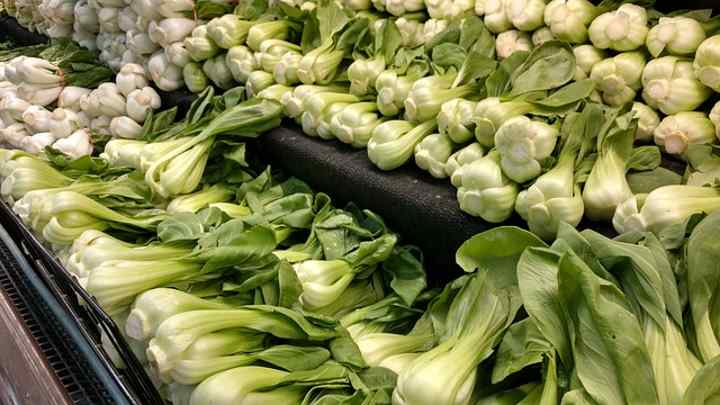
Bok Choy is another type of Chinese cabbage with loose green leaves
Another type of Chinese cabbage with thin tender white and green leaves is Bok choy (Brassica rapa chinensis). Bok choy (also called pak choi) is a member of the cruciferous family of leafy green vegetables.
Unlike Napa Chinese cabbage, Bok choy doesn’t form a head. It has a white bulb-type base from which dark green leaves grow. Regular Bok choy has crinkly green leaves and a crunchy white stem. This type of Chinese cabbage is perfect for stir-fries.
Other types of Bok choy (Shanghai Bok choy) are not as crisp and will become soft and mushy if cooked for too long. This type of Bok choy is generally cheaper and more widely available than regular Bok choy.
Similar to other types of cabbage, Bok choy is a good source of minerals and vitamins. The leaves contain good amounts of vitamins A, C, and K as well as some vitamin B6.
Kale (Leaf Cabbage)
Kale is one of certain cultivars of cabbage, and this is why it is also called ‘leaf cabbage’. Kale belongs the Brassica genus and is one of the healthiest types of cabbage you can eat. Unlike other types of common cabbage varieties, kale doesn’t form a cabbage head. The dark green crinkled leaves fan out from a central stem. Due to the shape of its leaves, some types of kale are also called ‘curly kale.’
Kale leaves can be quite tough and unpleasant to eat raw. To prepare kale, it is best to quickly blanch the leaves to soften them and help retain all their nutrients. In fact, because kale is so good for you, it is classed among the healthy superfoods. For example, a cup of chopped kale contains your daily requirements of vitamins A, C, and K. (2)
Just as there are many varieties of cabbage, so there are different kinds of kale. For example, there are curly kale, bumpy leaf-kale, plain-leaf kale, and leaf and spear kale. Varieties of kale also come in different colors such as dark green, purple, and blueish-green.
There are also ornamental types of kale that grow pink, white, lavender, or blue-colored flowers. These kale varieties are also an edible type of cabbage. However, people tend not to eat them as they are not very palatable.
Tuscan Cabbage
Tuscan cabbage (Lacinato kale) is a type of dark green black-leafed kale that is more commonly known as ‘cavolo nero’ or ‘black cabbage.’
This black kale plant is a large type of cabbage plant. The leaves can grow between 2 and 3 ft. (0.6 – 0.9 m) tall. Some people describe the shape of the Tuscan cabbage plant as resembling the leaves on a palm tree.
This black cabbage variety has long thin crinkly leaves. Actually, the leaves are a darker blue-green color. However, when it is cooked the “Tuscany way,” it turns almost black. Cooked Tuscan cabbage develops a silky texture and has a glossy shine. There is a slight bitterness to the cooked cavolo nero which can complement some dishes.
January King Cabbage
The January King cabbage is a Brassica cultivar and is one of the more unusual ‘head’ cabbages due to its interesting green and purple coloring. The leaves of the January King cabbage have the texture of a savoy cabbage but the shape of a white cabbage.
The Brassica oleracea sabauda (January King) has green colored leaves at the base that change to dark purple or red color at the top. The heads of this type of cabbage are small to medium in size and weigh between 3 and 5 lbs (1.4 – 2.3 kg).
To eat this delicious type of cabbage, prepare it similar to a savoy cabbage. In fact, you can use this in place of Savoy cabbage to add some color to a dish. Another cooking tip for the January King cabbage is to roast sliced or shredded cabbage leaves with some butter.
Portuguese Cabbage
Portuguese cabbage is a green cabbage cultivar that has large oval-shaped leaves with distinct white veins and a thick stem.
This Portuguese cabbage variety grows similar to kale in that it doesn’t form a cabbage head. Usually, the base of the thick white stem is not consumed. But all other parts of the leave are used in cooking. Compared to kale, Portuguese cabbage is more succulent and has a sweeter taste.
The thick hardy leaves of Portugal cabbage make a delicious addition to soups and stews. As with other types of cabbage, this Brassica cultivar is a rich source of vitamins and minerals.
Portugal cabbage is also one of the few varieties of cabbage that can grow well in both hot and cold conditions.
How to Choose the Best Type of Cabbage
When choosing a cabbage to buy, there are a few ways to tell if the cabbage is good.
First of all, the cabbage head should feel solid and only have a few loose leaves around it. The outer leaves should be fairly firm and not feel limp at all. Remember, that Savoy cabbages have less densely packed leaves and, therefore, the head will feel looser than regular cabbages. Green cabbages in the winter and early spring will be pale green almost white whereas newly harvested cabbages in summer and fall will be a light green color.



